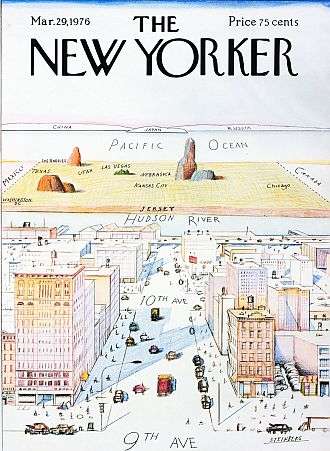Flyover Country

Boasting some of the most spectacular public restrooms, gas stations, and 24-hour Hardee's drive-thrus in the country, America's Midwest is conveniently located between where you are and where you are going.—The Onion: Our Dumb World
They've never drove through Indiana
They'd understand why God made those fly over states
Met the man who plowed that earth
Planted that seed, busted his ass for you and me
Or caught a harvest moon in Kansas—Jason Aldean, "Fly Over States"
Where do you live? New York? Awesome. L.A.? Awesome. Kansas City? Uh... where is that, like, in Missouri or something?
That's Flyover Country—American slang for the states which trendy coast-dwellers only see from the window of an airplane.[1] Containing roughly half the country's population (if you're using a narrower definition) but much more of its landmass, this region includes everything between Las Vegas and Chicago at a minimum—and is often extended to everything east of the Sierra Nevada and west of the Alleghenies (if not the Hudson River). Sparsely populated, largely rural, and lacking in mediagenic glamour, it rarely shows up in works which attempt to appear trendy or up-to-date. It gets much more play in political circles, however, as the quirks of the American electoral system make appeals to smaller states essential. When one talks about the "red state/blue state" divide in American politics, this is what is meant by "red state".
Setting a show or a novel here can be shorthand for '50s-style social conservatism, small-town insularity, or a crushingly unhip, even dorky ambiance—think Pleasantville or Napoleon Dynamite. However, it gets used at least as often to inspire Nostalgia Filter for Eagle Land Flavor #1, a friendly, down-home environment full of old-time family values where all the women are strong, all the men are good-lookin' and all the children are above average. When used in media, it often overlaps with Everytown, America, Down on the Farm or the Deep South.
Needless to say, the truth is a little different. While the states of the central U.S. do skew more rural than urban, the cities therein are as cosmopolitan as any coastal town. There's plenty of culture and nightlife to be found in cities like Minneapolis, Kansas City, or Omaha (a full listed of often-featured cities is included at the end), and they have a much lower cost of living than the coasts. And even some of the smaller towns, like Boulder, Colorado[2] and Ann Arbor, Michigan,[3] have their own quirks. There are very few states in the US that don't have at least one significant metropolitan area.
Politically, the cities and their metro areas are also more liberal than the surrounding region. Many of them are (or were) industrial towns with a strong presence of labor unions and minorities, plus college students who stuck around after graduating or dropping out. In fact, people in the surrounding, rural areas who don't fit in with the arch-conservative lifestyle will tend to relocate to the nearest decent-sized city. These factors lead to interesting scenarios where you have Democratic islands within states that are Republican strongholds.
These nuances and many more tend to be lost on Hollywood. Shows based in one of the coasts will lovingly show details of the landmarks and locales (Sex and the City was known for using real-life bars and restaurants as the girls' hangouts), while Midwestern locations are either fictionalized or used as a generic backdrop. This is because Indianapolis might as well be Addis Ababa to those who write TV shows and movies.
The part about the boring landscape, however, is true for the Great Plains, which covers much of the region but not the whole thing. While the cities can be quite interesting, outside of the cities is mostly just hundreds of miles of corn, wheat, and soybeans, broken by the occasional vast and ungodly foul-smelling cattle feedlot. Things do change once you hit Indiana, however, as it and everything to the south and east have a fair deal of hills, ravines, and forest, providing slightly more to look at from the highway than cornfields.
More charitable definitions of the term refer to smaller areas of the country, but tend to imply that those areas which do qualify are nasty pieces of work. Like, Deliverance nasty. "Flyaround Country" might better capture the implications we're shooting for here.
As mentioned above, if a show is actually based in one of the cities here, whether or not it's a subversion of this trope depends on how much research the writer has done (read: usually not much). However, the following locales in Middle America tend to feature highly in media:
- Chicago, Illinois[4]
- Cleveland Rocks, Ohio
- Denver, Colorado
- Indianapolis, Indiana
- Kansas City, Missouri
- Michigan
- Milwaukee, Wisconsin
- Minneapolis and St. Paul, Minnesota
- Pennsylvania (outside of Philadelphia)[5]
- Texas
- Utah
- Upstate New York[6]
See Land Down Under for the Australian equivalent.
- ↑ Ironically, none of the states in "Flyover Country" are the most flown-over - thanks to the Toronto-Atlanta and Toronto-Cuba traffic, the most flown-over state is Virginia.
- ↑ where Mork and Mindy was set
- ↑ home of the University of Michigan
- ↑ Sometimes. It's big enough that many people consider it a separate entity, though it's still often looked down upon by some of the more provincial New Yorkers as a "wannabe" Big Applesauce.
- ↑ This dichotomy also exists on a smaller scale within the state itself. Political strategist James Carville once described Pennsylvania as "Philadelphia in the east, Pittsburgh in the west and Alabama in the middle", the latter referring to the central part of the state with its coal mining and farming towns. The nickname "Pennsyltucky" describes this section of the state, carrying many of the same connotations within Pennsylvania that "flyover country" does within the US in general.
- ↑ Technically outside the region, but often given the same treatment, especially by people from New York City.